Abstract
The study is focused on ultra-light foam concrete (FC) aimed as a thermal insulation material. Two important properties of such material were investigated: compressive strength and thermal conductivity. In the conducted tests, the influence of the air-dry density (200–500 kg/m3), type of foaming agent (synthetic and protein) and binder type (ordinary Portland cement—OPC; calcium sulphoaluminate cement—CSA; metakaolin; siliceous fly ash—SFA; calcareous fly ash—CFA) on the mentioned properties were examined. The results confirmed the dependence of compressive strength and thermal conductivity on the FC density but also indicated the important effect of the nature of the foaming agent and the binder type. The best thermo-mechanical properties were obtained for the foam concrete made of protein-based foaming agent, OPC and metakaolin. Simultaneously, the use of CSA mixed with metakaolin and foam based on the synthetic foaming agent also shows satisfactory properties.
1. Introduction
The increasing need for improving the building design with enhanced thermal resistance and energy storage capacity results in searching for a material characterized by i.e., low unit weight, high mechanical performance, high durability and high service performance in terms of fire resistance and thermal insulation [1]. In this sense, the attention of the researchers and practitioners has been recently redirected towards the potential use of foam concrete (FC), which is not a particularly new material as the first patent and recorded use of it dates to the early 1920s [2]. Over the years, the production of foam concrete has been developed and improved. Due to its cellular microstructure foam concrete has up to 80% lower weight compared to ordinary Portland cement (OPC)-based concrete, excellent thermal and acoustic insulation properties as well as higher fire resistance [3,4]. Furthermore, as the application of the FC results in relatively less consumption of OPC paste per unit volume, it indicates reduced CO2 emissions [5]. That effect might be enhanced as researchers show interest in foam concrete as a potential for large-scale utilization of wastes such as rubber [6,7], fly ash [6,8], expanded vermiculite [9], marble powder [10] or rice husk ash [11]. Furthermore, by-products and wastes are utilized in geopolymer foam concrete [12]. Considering the mentioned properties, foam concrete may create an alternative for the commonly used materials such as extruded polystyrene (XPS) boards, which utilization results in unavoidable degradation due to long-term moisture infiltration [13]. However, the application of the foam concrete as a thermal insulator requires the determination of the optimum parameters that balance the mechanical strength and insulating effect. Crucial in this case is proper density selection [14], considering the influence of density on the compressive strength and thermal insulation properties is contradictory: increasing the density of foam concrete causes the increase in the compressive strength with a simultaneous decrease in the insulating effect. Furthermore, it should be mentioned that the production of stable foam concrete is determined by many factors, including the type of the foaming agent, method of foam production and addition, mixture selection and design, method of production of the foam concrete, its performance, etc. [3,15]. The foam stability and the relatively low compressive strength of the foam concrete have been recognized as the main challenges in using this material [16].
The overview of the compressive strength of foam concrete with various mixture compositions and densities presented in [3,15] showed the exponential decrease in the compressive strength with the reduction in the density of foam concrete. The review of research on the compressive strength reported in the literature also revealed that the density of foam concrete usually varies from 400 kg/m3 to 1600 kg/m3 [17], while the target density of lightweight FC usually equals 600 or 800 kg/m3, and for ultra-lightweight FC 400 kg/m3 [1]. Only a few studies are devoted to materials of a density lower than 400 kg/m3.
The effect of the chosen factors, such as the water to cement ratio of FC with the density of 400–800 kg/m3 [18], the water content of FC with the density of 300–800 kg/m3 [19], different filler type of FC with the density of 1200–1600 kg/m3 [20,21], fiber content, curing conditions and dry density of FC with the density of 400–800 kg/m3 [22] on mechanical properties is the subject of the above-mentioned studies. The compressive strength tests of the materials with the lower densities are rarely performed; nevertheless, the expected strength is extremely low in comparison with standard concrete, as indicated in [23], where the concrete with a density of 120–240 kg/m3 was investigated. Improvements in strength and ductility were observed under triaxial compression for a low confinement level (30% of the compressive strength), while for the higher levels, the damage caused by confinement did not benefit in terms of strength and/or ductility/toughness. In all uniaxial and triaxial compression tests, the damage by the disaggregation of the material skeleton has been observed [23].
Regarding thermal properties of FC, authors of [24] have found the lightweight foam concrete, with a density of 600–1800 kg/m3, a suitable material for building use as insulating or fire resisting material due to the porous internal structure, thus very low thermal conductivity. Thermal properties of foam concrete can be improved by several types of additives, i.e., coir fiber, which applied resulted in higher heat capacity and lower thermal conductivity of the FC [25], as well as polypropylene fibers [26], which allowed for the reduction in the thermal conductivity and improved the mechanical properties of foam concrete. Moreover, the degree of thermal insulation in FC might be influenced by the mixture composition, such as aggregate type and mineral admixtures [27]. Next, according to [4], conductivity associated with FC based on a synthetic foaming agent was less sensitive to change in air content than concrete produced using a protein-based foaming agent.
The thermal conductivity of FC depends on density, moisture content and components used in the material [28]. The number of pores and their distribution have a crucial effect on thermal insulation. Based on [29], foam concrete’s thermal conductivity values constitute 5–30% of the obtained for normal concrete and range from 0.1 to 0.7 Wm−1K−1 for dry density values of 600–1600 kg/m3, reducing with decreasing densities. These findings are consistent with the results obtained in [30], where the thermal conductivity of foam concrete ranged from 0.389 to 0.734 Wm−1K−1 at a density of 1200, 1400 and 1600 kg/m3. For the foam concrete of the density from 860 kg/m3 to 1245 kg/m3, the thermal conductivity varied from 0.021 to 0.035 Wm−1K−1 [17].
This study aims to investigate the ultra-lightweight foam concrete of rarely studied density ranges (200–500 kg/m3), looking for the most favorable configuration of properties of such feasible insulating material: compressive strength and thermal conductivity. In the conducted tests, the influence of the density, synthetic and protein foaming agents as well as binder type on the above-mentioned properties was examined. The wide range of the tested densities below 500 kg/m3 allowed for the identification of properties and their dependencies significant for the potential use of foam concrete as a thermal insulation material.
The paper is divided into four sections. After this introduction with the review of the recent studies in the discussed field, Section 2 presents the materials applied in foam concrete, the method of its production as well the testing methods. The results of the performed experimental tests with a brief discussion are provided in Section 3. Finally, the main conclusions obtained for the ultra-light foam concrete are summarized in Section 4.
2. Materials and Testing Methods
2.1. Materials and Foam Concrete Mixture
In the cement paste, a commercially available ordinary Portland cement CEM I 52.5 R (OPC) and calcium sulphoaluminate cement (CSA) are used. There are several reasons for testing CSA cement as an alternative binder in foam concrete. First of all, CSA can be considered a more environmentally friendly material than OPC since the lower amounts of limestone involved in the production process, as well as lower burning temperature, generate reduced CO2 emissions per 1 ton of clinker in comparison to Portland clinker [31,32]. Next, the properties of CSA cement such as short initial and final setting time as well as high early strength may be beneficial for the ultra-light foam concrete [32,33].
Generally, in addition to the cement, metakaolin (MK) is applied as a binder, but in some mixes siliceous fly ash (SFA) or calcareous fly ash (CFA) replaced metakaolin. Although cement is a dominant binder in foam concrete, supplementary cementitious materials are usually applied to improve mix design consistency, the pore and void structures as well as for the refinement of foam bubble stability [27]. Additionally, some types of SCMs, for example fly ashes or silica fume, may also improve desirable properties such as compressive and tensile strength or early age shrinkage behavior [34].
The chemical composition of the binders is listed in Table 1. Both fly ashes complied with the requirements of standard PN-EN 197-1 [35]. The water/binder ratio of the cement paste was assumed to be 0.4, which has been found to be adequate for foam concrete [6,28]. Polycarboxylate ether superplasticizer is added to achieve the required consistency while the stabilizer, based on the organic components, ensured the homogeneity and stability of the mixture. Later, after mixing the paste with the foam, the stabilizer prevents the excessive destruction of pores, especially if the foam concrete is pumped. Furthermore, the hardening accelerator, based on calcium nitrate, was implemented to speed up the hardening process and the porous structure formation, as well as the improvement in the stability of pore size. The cement paste composition is depicted in Table 2. The foam with the density of 70 kg/m3 was produced using two foaming agents: synthetic and protein-based, both in an amount of 2% in respect to the water volume used to make the foam. The basic features of the foaming agents are given in Table 3. Finally, the voluminous content of the paste in the foam concrete for wet density and the first approximation of air-dry density, considering only the subtraction of water contained in the foam, is presented graphically in Figure 1.

Table 1.
Chemical composition of used binders.

Table 2.
Cement paste composition.

Table 3.
Properties of foaming agents.
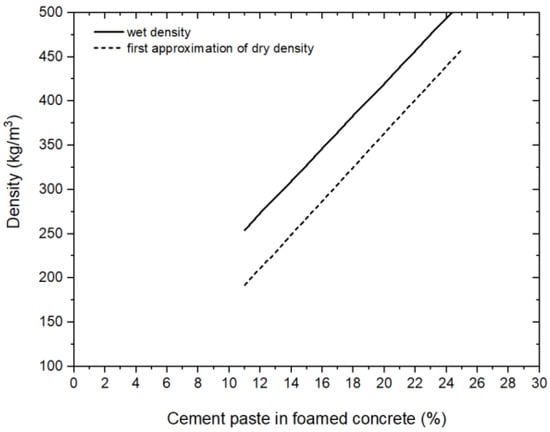
Figure 1.
Voluminous content of paste in the foam concrete with wet and the first approximation of air-dry density.
Altogether, five foam concrete mixtures with air-dry densities ranging between 200 kg/m3 and 500 kg/m3 were considered. For all desired densities, the same proportion of the mixture components was used, varying only the appropriate ingredients. Four mixtures were tested with the synthetic foaming agent, while only one based on the protein foaming agent was examined (Table 4). This is mainly due to two reasons. Firstly, replacing metakaolin by SFA or CFA did not improve the foam concrete properties, so these materials were not examined for the protein-based foaming agent. In the case of CSA cement and protein-based foaming agent, the foam concrete was destroyed immediately after mixing the paste and foam (the bubbles in foam were damaged). Therefore, the possibility of using CSA cement with a protein-based foaming agent requires further research to identify the chemical interaction and the causes of foam concrete destruction, as well as possible correction of its composition with CSA.

Table 4.
The tested foam concrete mixtures.
2.2. Production of Foam Concrete
The foam concrete samples were prepared using the pre-forming method. The first step in this method is to prepare the paste. Thus, cement with metakaolin (or SFA, or CFA) was hand-mixed until a homogeneous appearance was achieved. Next, the obtained binder was mixed with water for 120 s followed by the superplasticizer and mixed for another 60 s. The stabilizer was added to the mixture for 90 s. Finally, the hardening agent was added and mixed for 90 s. Then, the mixing was stopped for 60 s and resumed for another 60 s (Figure 2). This procedure allowed us to obtain a homogenous paste.

Figure 2.
Preparation of the paste.
The foam was produced using the Gertec foam generator, which is a compact device for the continuous production of foam (Figure 3a). The parameters controlling the produced foam are the water flow, compressed air flow and foaming agent concentration. The performed experimental tests showed that the foam with a given density can be obtained with different generator settings (Figure 3b). In the conducted tests, foam with a density of 70 kg/m3 was produced under the settings of 40 dm3/min (40 L/min) of compressed air and 3 dm3/min (3 L/min) of water. The concentration of the foaming agent was 2% of the water volume. The produced protein-based foam and microscopic photos of the foam with a density of 70 kg/m3 are shown in Figure 4a,b. Good quality foam with small and uniform air bubbles was obtained (Figure 4b). The first liquid at the bottom was observed after 90 min; however, the height was kept almost constant over the next 90 min (Figure 4a). Similar properties were noted for the synthetic foaming agent.
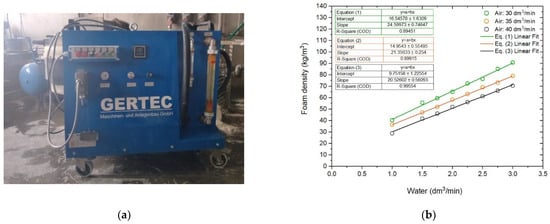
Figure 3.
(a) Foam generator and (b) its settings.
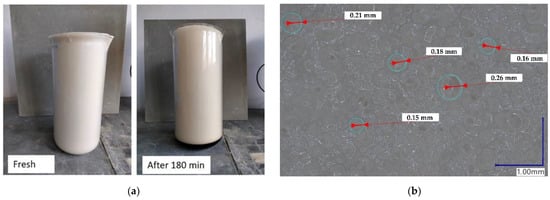
Figure 4.
(a) The produced protein-based foam and (b) the structure of the foam with a density of 70 kg/m3.
The foam was produced concurrently with the control of the assumed density. Afterwards, the foam had been gradually added to the cement paste and successively mixed until a homogeneous mixture was obtained. Finally, the foam concrete was poured into molds, which were 100 × 100 × 100 mm3 and 300 × 300 × 100 mm3, without any vibration (Figure 5a). A few samples 150 × 150 × 150 mm3 are also produced, mainly for the thermal tests. The exemplary set of samples is visible in Figure 5a,b.
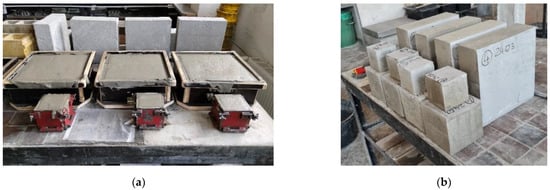
Figure 5.
Exemplary foam concrete samples: (a) after filling the molds; (b) before cutting and testing.
2.3. Testing Methods
The compressive strength was tested on the cubic specimens 100 × 100 × 100 mm3 (Figure 6a), according to the standard PN-EN 12390-3:2019-07 [36]. These cubic samples were produced both directly from the molds of the same dimensions as well as from the bigger ones (300 × 300 × 100 mm3), after a cutting process. All specimens were stored in the molds for 24 h. Next, the demolded samples continued curing for 28 days at a temperature of 20 °C and 60% relative humidity. Considering the different densities and other variable factors such as cement type, foaming agent, foam density and filling agent, in total, 117 samples were tested.
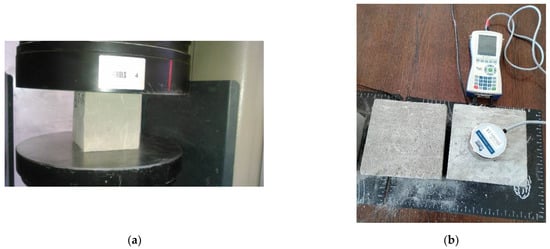
Figure 6.
The measurements of the foam concrete (a) mechanical and (b) thermal properties.
The thermal conductivity was measured using the thermal analyzer Isomet 2114 [37], which is a multi-functional device for the measurement of thermal conductivity, thermal diffusivity and volume heat capacity. In the performed tests, the surface probe with the measurements range 0.04–0.3 Wm−1K−1 was used. The device applies a dynamic measurement method, which reduces the measurement time in comparison with steady-state measurement methods. The dynamic method is based on the analysis of the temperature response of the analyzed material to heat flow impulses. Heat flow is excited by electrical heating of a resistor heater inserted into the probe which is in direct heat contact with the tested specimen. The evaluation of thermal conductivity is based on periodically sampled temperature records as a function of time, provided that heat propagation occurs in an unlimited medium. The measurement with the described device does not require any calculations and the results of the thermal conductivity measurement are visible on the display and recorded in a file after the measurement is completed. The advantage of this mobile device is also the possibility of using it in field tests. Nevertheless, the comparative analysis shown in [32] indicates that in the case of thermal insulation materials, the accuracy of this method can be considered high only for the tested samples with a thickness of at least 100 mm. In the case of the lower thickness of the tested material, the obtained thermal conductivity may be overestimated, compared to steady-state measurement methods. Hence, the thermal properties of the foam concrete were measured on the samples with a thickness of 100 mm. The study consisted of nine measurements of one sample with a particular density. The device during the test of the specimens is presented in Figure 6b. Considering the different densities and other variable factors such as cement type, foaming agent, foam density and filling agent, in total, 56 specimens were tested.
3. Results and Discussion
3.1. The Structure of Foam Concrete
The microscopic images of four specimens with a density of 300 kg/m3 are shown in Figure 7. The differences in the structure of the concrete foam produced with different components are quite evident and may be attributed not only to the various foaming agents but also to the type of cement and additional binder. Comparing ordinary Portland cement (OPC) with metakaolin (Figure 7a) or calcareous fly ash (Figure 7b), in both samples, small voids are intertwined with large ones, but generally, a similar size of air voids can be seen, with a maximum diameter of about 1 mm. However, in the case of calcareous fly ash, the structure of the material is less regular than for metakaolin, and air voids have a rough, sharp shape. It should be noted that such an irregular shape has a significant impact on the compressive strength [1,38], which was later confirmed in its registered values. The structure of the foam concrete based on the synthetic agent was significantly improved when CSA cement with metakaolin was employed (Figure 7c). In this case, very small, regular-shaped voids predominate, with a diameter in the range of 0.2–0.4 mm. They are accompanied by a relatively small number of larger air voids (about 1 mm) randomly distributed. A similar structure was obtained for concrete with a protein-based foaming agent, although, with glassy smooth air voids and only a few larger voids, seen in Figure 7d.
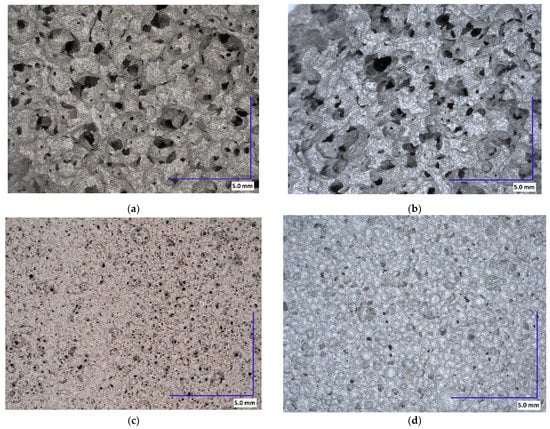
Figure 7.
Microscopic photos of the foam concrete with an average density of 300 kg/m3: (a) OPC/metakaolin/synthetic foaming agent; (b) OPC/CFA/synthetic foaming agent; (c) CSA/metakaolin/synthetic foaming agent; (d) OPC/metakaolin/protein-based foaming agent (the scale size is shown in the bottom right corner of each photo).
The difference between the effects of two investigated foaming agents on the structure of foam concrete can be attributed to the difference in their composition. Protein-based foaming agent works based on small hydrophobic molecules resulting from the degradation of proteins in the agent, and thus it not only causes the reduction in the surface tension but additionally builds up hydrogen bonds in the solution leading to stable, small air bubbles [39]. Synthetic foaming agents, on the other hand, introduce hydrophilic, amphiprotic substances to the water, which results in air bubbles appearing [4]. This in turn does not support small bubbles well, and therefore, the structure of the concrete with a synthetic foaming agent has bigger air voids.
Subsequent images for foam concrete based on the synthetic foaming agent with different densities (200, 380 kg/m3) show that the uniformity of the structure and regularity of the air voids increases with higher density, both in the case of OPC (Figure 8a,b) and CSA cement (Figure 8c,d). It is especially noticeable for OPC cement, because for CSA, even for low density, the concrete structure is very uniform.
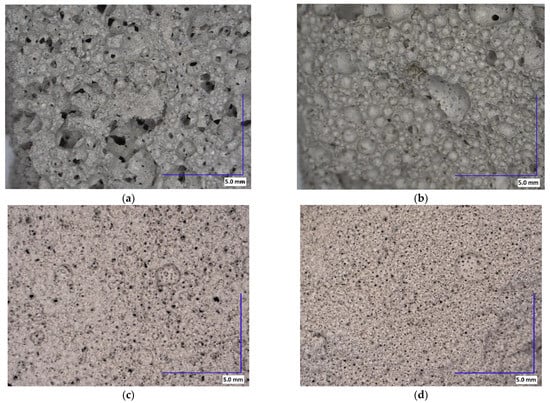
Figure 8.
Microscopic photos of the foam concrete with metakaolin and synthetic foaming agent with different densities: (a) OPC, 200 kg/m3; (b) OPC, 380 kg/m3; (c) CSA, 200 kg/m3; (d) CSA, 380 kg/m3 (the scale size is shown in the bottom right corner of each photo).
3.2. Air-Dry Density of Foam Concrete
Concrete foam with examined low densities requires a high amount of foam introduced to the mixture. Consequently, this need leads to the elevated total water/binder ratio, where water is the sum of water contained in the paste and foam. Thereupon, the weight loss from the wet state to the dry state is significant. In this regard, the recommended maximum difference between the fresh and dry density of the foam concrete should not exceed 100–120 kg/m3 [40]. At the same time, a relatively large tolerance of the actual densities of dry foam concrete is allowed and ±50 kg/m3 is the acceptable difference in obtained values for the light FC [41].
Therefore, the prediction of the dry density of FC and designing its composition with the proper wet density is the key target in its performance. Generally, it can be assumed that the water which cannot be evaporated by the standard drying in the oven (105 ± 5 °C) is equal directly to water chemically bonded with the binder [27,34]. Following this approach, the dry density of the foam concrete, after the standard oven treatment, can be predicted based on the total binder employed in the mixture:
where is the oven dry density (kg/m3), is the coefficient representing the amount of water remaining in dry FC and is the amount of the binder used for FC (kg/m3). Typically, the suggested value of the coefficient is 0.2 [27,34], assuming that bonded water is equal to the average 20 wt.-% of the binder. Nevertheless, some studies [42] reported lower percentages of bound water, depending on the cement type and water/cement ratio. In [43], the amount of non-evaporable water is mentioned as 23% of the binder.
While oven dry density is a good benchmark for comparing different test results, it is not entirely suitable for real concrete production conditions. Hence, it is necessary to determine what the common term “target density” is: dry density is obtained after the standard drying (105 ± 5 °C), or the stabilized air-dry density in average temperature and humidity conditions. Preliminary, the planned concrete air-dry density after 28 days can be determined assuming that all the water contained in the foam will evaporate:
where is the water/binder ratio and is the amount of the admixtures used for FC (kg/m3).
Based on the performed tests, the percentage difference between the density of the freshly produced samples and the air-dry density after curing at 20 °C and 60% RH, was calculated as follows:
where is the density of the fresh FC mixture and is the density after 28 days of curing at the mentioned conditions. The obtained results for two tested foaming agents and two types of cement, relating to three densities, are depicted in Figure 9. As expected, the decreasing density of the foam concrete leads to an increase in the difference between the fresh and air-dry state density. This can be explained by the existing higher liquid phase caused by the high content of the foam, necessary to obtain the ultra-light foam concrete. Thus, the considerable weight and density reduction is justified. Furthermore, the discussed density loss takes the highest values for the protein-based foaming agent, and for ultra-light foam concrete with the fresh density of 255 kg/m3, this loss reaches 37% of the fresh density. The similar effect was observed in samples made of synthetic foaming agent, but the discussed reduction was lower. In this case, for the lightest FC samples, the loss of density was on average 22.6% in the case of CSA cement and 27.2% for ordinary Portland cement.
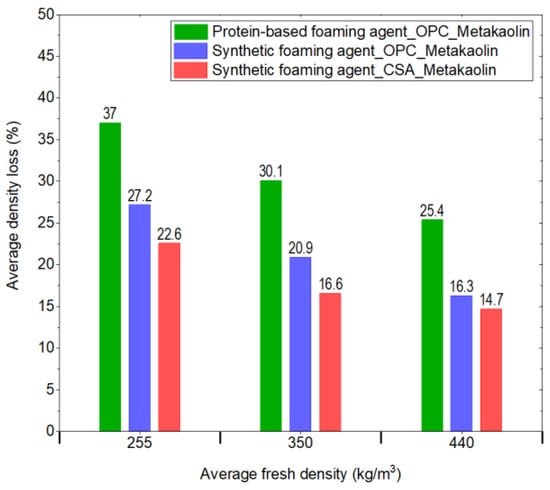
Figure 9.
The influence of the foaming agent and cement on the change in density from fresh to air-dry state.
The difference between the effect of the foaming agents could be caused by the fact that the specific surface of the air voids is higher for the protein-based foaming agent, and the voids themselves are observed to be more regular. This may mean that more water is necessary to create the foam structure, and thus does not take part in the hydration process, leading to more free water that can later evaporate. Nevertheless, this suggestion needs to be further investigated and confirmed.
Based on the presented results, the adjusted coefficient (corresponding to that in Equation (1)), valid for the air-dry curing condition, was estimated for the tested foam concrete. It means that it does not represent the chemically bonded water but the amount of water that still exists in the foam concrete after the 28-day air-dry curing. The relevant values are depicted in Table 5. It can be noticed that only in foam concrete with protein-based foaming agent the values of are close to the value of 0.2 mentioned earlier, based on the assumption that bonded water is equal to the average 20 wt.-% of the binder. This means that not only was the water evaporated from the foam, but also the water from the paste was evaporated and the final value of K (Equation (1)), considering the chemically bonded water, will be lower than 0.2.

Table 5.
Estimation of the -adjusted coefficient for air-dry curing (Equation (1)).
The especially high value of was estimated for CSA cement (0.45 on average) which is greater than applied water/binder ratio equal to 0.4. This can be explained by the higher water demand for the hydration of CSA cement [44,45] and at the same time means that this cement could use part of the water from the foam for its hydration. The values of for OPC cement and synthetic foaming agent are almost equal to the applied water/binder ratio stated as 0.4. Thus, there is a significant difference between the foaming agents, and with the protein agent, the observed rapid outflow of water from the samples associated with the lower foam stability creates worse conditions for internal curing. When using a synthetic agent, the foam is more stable and the loss of water is reduced, creating better conditions for hydration. Nevertheless, this issue should be further investigated and confirmed in terms of the optimal curing conditions, since it seems that in the foam concrete with the protein-based foaming agent the curing conditions should ensure a gentler drainage of water from the foam concrete. As a reminder, the tested samples were only in the molds for 24 h, then they were matured at 20 °C and 60% RH, without foil protection.
3.3. Compressive Strength
The results of the compressive strength tests were compared depending on the variable components used in the produced foam concrete (Figure 10, Figure 11, Figure 12 and Figure 13). Overall, an obvious relationship between density and strength was confirmed and the compressive strength increases with increasing density, regardless of the employed foam concrete composition. In Figure 10, the effect of replacing metakaolin with siliceous fly ash (SFA) or with calcareous fly ash (CFA) is shown. The reported results reveal that metakaolin is the best binder supplement added to OPC. The compressive strength obtained for foam concrete with metakaolin is higher and the samples made of mixed OPC and metakaolin exhibited values ranging from 0.05 to 0.82 MPa for the air-dry densities between 200 kg/m3 and 450 kg/m3. The samples with OPC blended with SFA or CFA revealed much lower compressive strength of 0.05–0.51 MPa for densities in the range of 220−450 kg/m3. At the same time, no significant difference was observed between SFA and CFA, the strength of foam concrete with SFA is only slightly higher (Figure 13).

Figure 10.
Compressive strength of foam concrete made of synthetic foaming agent with OPC mixed with metakaolin, or with SFA, or with CFA.
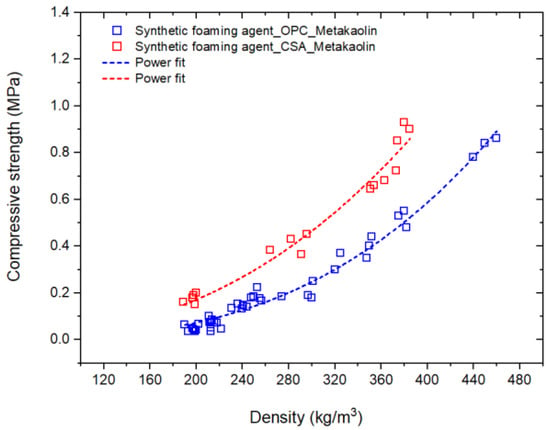
Figure 11.
Compressive strength of foam concrete made of a synthetic foaming agent with OPC or CSA and metakaolin.
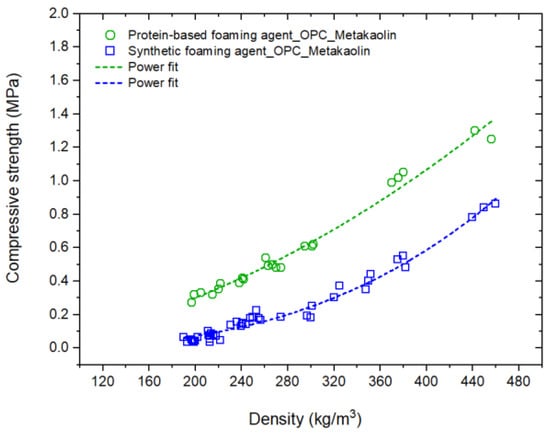
Figure 12.
Compressive strength of foam concrete made of OPC with synthetic or protein-based foaming agent and metakaolin.
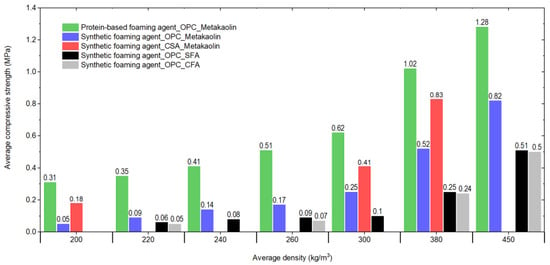
Figure 13.
Average compressive strength for all tested foam concrete.
Next, the comparison was made with reference to the cement type (Figure 11). The depicted results for foam concrete with the considered densities of 220−450 kg/m3 showed that samples with CSA cement are characterized by beneficial strength growth compared to ones with OPC. It is especially noticeable for low foam concrete densities, where for a density of 200 kg/m3, the compressive strength of CSA-based foam concrete is 0.18 MPa, while for OPC it is only 0.05 MPa (Figure 13). It may be explained by the substantial distinction of the structure of these foam concretes. The application of CSA cement allows us to obtain a more homogenous distribution of small air voids in foam concrete (Figure 8).
Moreover, the effect of the foaming agent with different natures was analyzed. Investigations on the performance of FC with different foaming agents showed the strong interaction between cement and foaming agent and distinguished the property of the gas–liquid interface of FC as the crucial factor determining its performance [46]. The results depicted in Figure 12 exhibited seriously higher compressive strength of foam concrete with protein-based foaming agent, which is consistent with the literature studies, indicating that protein-based foaming agents provide better compressive strength than synthetic ones [47]. Thus, the use of a protein-based foaming agent ensures an increase in the compressive strength, especially for low densities. For the air-dry density of 220 kg/m3, the strength is greater by approximately 280%, while for bigger densities it is not so significant and takes 56%. These results are in agreement with findings reported in other research studies [1,27,40,48]. Furthermore, in [1], for the FC of higher densities (400–800 kg/m3), the increase of approximately 60% in the compressive strength of FC occurred due to the increasing protein foaming agent concentration from 3% to 5%. Similarly, as in the comparison of CSA and OPC cement, the reason lies in the air void distribution and the structure homogeneity which affects the strength characteristics. It is worth noting, however, that in the case of a synthetic foaming agent, the foam concrete structure and its strength were significantly improved by the introduction of CSA cement. Additionally, in [39], the authors state that synthetic foaming agents can attain comparable strengths to protein ones on the condition that an increased water/cement ratio is adopted, which indices the crucial importance of the combination of the foaming agent with a particular w/c ratio (in this study, dry densities were ranging from around 350 up to 850 kg/m3). On the other hand, when comparing the properties of synthetic surfactants (SS), plant surfactants (PS) and animal glue/blood-based surfactants (AS) [49,50] used as foam agents in the FC with the density of 600 kg/m3, the synthetic surfactant-based foam concrete showed more beneficial pore size distributions, which accounted for the higher compressive strength, lower drying shrinkage and stronger frost resistance of FC, compared to the other two. As mentioned before, unfortunately, it was not possible to compare the CSA cement used together with the protein-based foaming agent since the foam added to the paste was immediately destroyed. Finally, all discussed results in terms of compressive strength are summarized in Figure 13 with visible clear evidence of the influence of the individual components used in the foam concrete.
Additionally, the obtained results of compressive strength were described by fitting curves, which are visible in Figure 10, Figure 11 and Figure 12. In the tested range of densities, both the exponential and the power functions gave a very good fit. Ultimately, the simple power function was chosen with coefficients for all tested mixture listed in Table 6. The coefficients of determination, R2, are also provided, with values generally higher than 0.91 and reaching 0.98, thus confirming the usefulness of the power function for the strength description.

Table 6.
Coefficients for the power fit—compressive strength ( ).
Nevertheless, the key question is whether including such equations is useful for predicting the strength of foam concrete. In the authors’ opinions, unfortunately not, particularly because the published results of other works and those presented above indicate a significant influence of many factors on the compressive strength. The results presented in this work, although they show the effect of the foaming agent and the binder type for a relatively wide range of low densities, were obtained for a foam with one density, under the given curing conditions. Thus, the development of a universal equation for predicting the strength of the foam concrete would require very extensive research, and the equation would have to take into account not only density but also all the other factors. Despite this criticism, the authors decided to include this analytical part that may be useful in some way for foam concrete with a similar composition and shows the overall trend of compressive strength versus density.
3.4. Thermal Conductivity
The results of thermal conductivity are presented in the same manner as in the previous section. Consequently, the measured values of the thermal conductivity tests were collected depending on the various components used in the examined foam concrete (Figure 14, Figure 15, Figure 16 and Figure 17). Generally, as previously described (Section 2), the enhanced thermal properties in relation to conventional concrete were proven. Generally, the measured thermal conductivity values range from 0.048 Wm−1K−1 to 0.079 Wm−1K−1 for air-dry densities below 500 kg/m3. Similarly, as expected, the thermal characteristics follow the density and the thermal conductivity decreases with the decrease in the density due to higher amount of the air voids. Nevertheless, the dependency of the thermal properties on the FC composition was also detected.
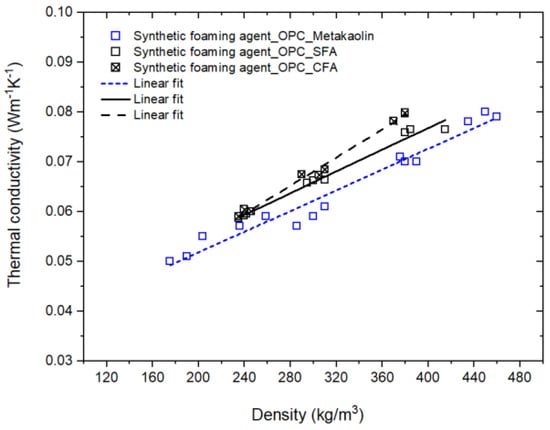
Figure 14.
Thermal conductivity of foam concrete made of synthetic foaming with OPC mixed with metakaolin, SFA or CFA.
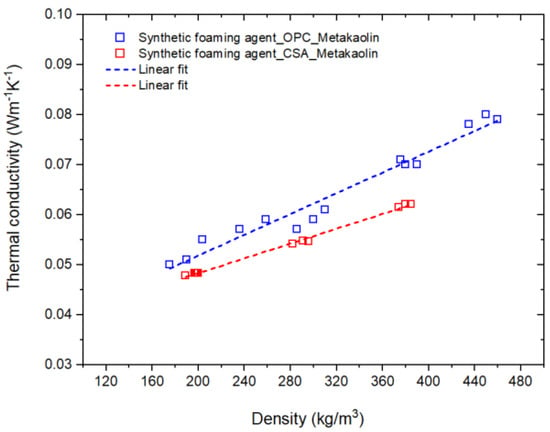
Figure 15.
Thermal conductivity of foam concrete made of synthetic foaming agent with OPC or CSA and metakaolin.
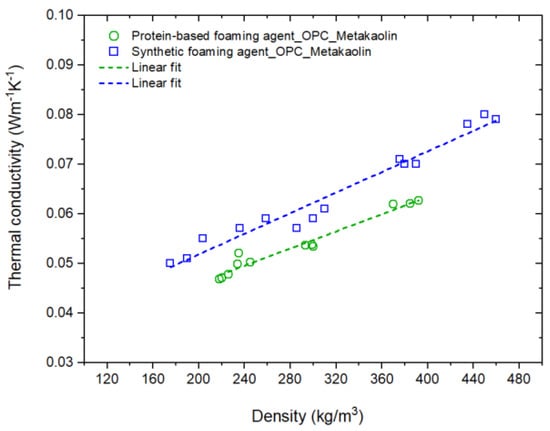
Figure 16.
Thermal conductivity of foam concrete made of OPC with synthetic or protein-based foaming agent.
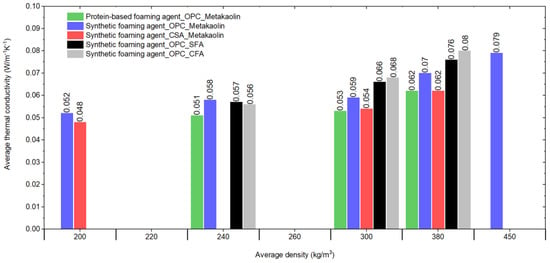
Figure 17.
Average thermal conductivity for all tested foam concrete.
In Figure 14, the influence of metakaolin, siliceous fly ash (SFA) and calcareous fly ash (CFA) used as a part of the binder is shown. Similarly, as in the compressive strength investigation, the measured thermal conductivity showed that metakaolin is the best binder supplement added to OPC. The samples made of OPC mixed with metakaolin give values in the range of 0.058 to 0.076 Wm−1K−1 for the air-dry densities between 240 kg/m3 and 380 kg/m3. The foam concrete with OPC blended with SFA or CFA showed slightly higher values of 0.057–0.08 Wm−1K−1 for the same densities range. Concurrently, a small difference was observed between SFA and CFA for the densities of 300–400 kg/m3, with the lower values of thermal conductivity for the foam concrete with SFA (Figure 14 and Figure 17). It may also be noted that for the smallest tested density of 240 kg/m3, no difference between metakaolin, SFA and CFA was detected.
Then, the cement type employed in foam concrete was compared in terms of thermal conductivity (Figure 15). The obtained results for foam concrete with the considered densities below 500 kg/m3 revealed the beneficial effect of CSA cement on thermal conductivity. Values in the range of 0.048–0.062 Wm−1K−1 were measured for CSA cement, while for OPC in the same density variation thermal conductivity was between 0.052 and 0.07 Wm−1K−1 (Figure 17). Once again, the reason lies in the substantial differences in the structure, since CSA cement ensures a more homogenous structure and uniform distribution of small air voids in foam concrete (Figure 8).
The last of the analyzed issues was the effect of the synthetic and protein-based foaming agents on the thermal behavior of foam concrete. The results depicted in Figure 16 indicated better thermal properties for the foam concrete made with a protein-based foaming agent. Then, the use of a protein-based foaming agent ensures a substantial decrease in values of thermal conductivity for all investigated densities. For the air-dry density of 240 kg/m3, the thermal conductivity was measured at the level of 0.051 Wm−1K−1 for the protein-based foaming agent and 0.058 Wm−1K−1 was registered for the synthetic one. Similar results of the conductivity tests for protein-based foaming agent FC were obtained in [23], where the thermal conductivity of 0.0505 Wm−1K−1 (for density of 160 kg/m3) and of 0.0568 Wm−1K−1 (for density of 191.55 kg/m3) was noted. Additionally, in such low ranges of density, a nearly linear dependence of thermal conductivity against the dry density was observed; however, the obtained variance in values indicates the complex relation between thermal conductivity, the density, the air-void distribution, w/c ratio and the glue composition of the composites [14]. It may be noted that similar or even the same thermal conductivity was achieved for FC with a synthetic foaming agent and CSA cement as for FC based on the protein foaming agent and OPC cement. So, the introduction of CSA cement significantly improved not only the compressive strength but also the thermal properties. All obtained results relating to thermal conductivity are summarized in Figure 17 with the visible influence of all investigated individual components of foam concrete.
Finally, the analysis of the thermal conductivity dependency on the density detects the linear fit as a best-fitting curve for the considered range of FC densities (Figure 14, Figure 15 and Figure 16). The coefficients of the linear fit are depicted in Table 7. Especially high values of the coefficient of determination, R2, in the range of 0.96–0.99 were achieved. Hence, the linear interpolation was confirmed as a realistic description of the thermal conductivity and density relation in the range of the tested FC densities. Of course, the comments and limitations of the approximation curves mentioned in Section 3.3 in terms of compressive strength are also valid in this case.

Table 7.
Coefficients for the linear fit—thermal conductivity (λ).
4. Conclusions
The presented study is focused on the decisive properties of the ultra-light foam concrete for thermal insulation application in civil engineering. A relatively large range of tested densities made it possible to investigate the influence of the type of foaming agent and the type of binder on the characteristics of foam concrete. Therefore, the presented results add more insight to the common effect of the mentioned various components of FC on structure, compressive strength and thermal conductivity.
The following conclusions could be drawn:
- The results confirmed the well-known dependency: the strongly intended lower density is associated with the lower compressive strength of FC, but at the same time, the desired lower conductivity relates to lower density. Hence, a balance between these distinguishing features should be sought to minimize thermal conductivity and maximize strength as much as possible.
- Not only does the density affect the compressive strength and thermal conductivity, but it also affects the foam concrete structure. Synthetic or protein nature of the foaming agent contributes to differences in air-void distribution and as a result the structure of the foam concrete. The use of protein-based foaming agent resulted in predominantly very small, regular-shaped voids that make the structure more uniform. Then, the much better thermo-mechanical properties were obtained for the concrete made of protein-based foaming agent. In this case, the compressive strength was higher with lower thermal conductivity.
- Replacement of ordinary Portland cement (OPC) with calcium sulphoaluminate (CSA) cement created low density foam concrete with the uniformity of the structure and regularity of the air voids. Thus, CSA cement significantly improved the mechanical and thermal behavior of FC with a synthetic foaming agent. Hence, the use of CSA cement shows promising results and has the potential of being applied to the foam concrete. Unfortunately, CSA cement employed together with a protein-based foaming agent led to the foam destruction immediately after mixing the paste and foam. Further research in this regard is necessary.
- Substitution of metakaolin with silicious fly ash (SFA) or calcareous fly ash (CFA) did not bring positive effects in terms of all the tested foam concrete properties. The addition of metakaolin as part of the binder appears to be the best solution.
- A disparity in the water release from the foam concrete samples was noticed for two types of foaming agents. For the curing conditions applied in the tests, in the foam concrete with the protein foaming agent, the rapid outflow of water from the samples was observed. In the foam concrete with a synthetic foaming agent, the loss of water was reduced, and its rate is slower. It gives a preliminary diagnosis of potential shrinkage problems and the necessity of the special curing conditions ensuring a gentler transfer of water from the foam concrete based on the protein foaming agent.
Finally, it seems that ultra-light foam concrete with favorable thermal properties may be used as an insulation material. The compressive strength also seems satisfactory; however, it is always necessary to choose the density of the foam concrete to ensure the best thermal properties with the simultaneous provision of the strength requirements. It should be noted that European standards have been developed for other insulation materials, such as expanded polystyrene or mineral wool, but there is no such standard for the potential use of foam concrete and its properties. It is necessary to develop such standards which allow the wide use of foam concrete as an insulating material, since, compared to common thermal insulation materials such as expanded polystyrene or mineral wool, foam concrete may be considered a sustainable alternative. In this regard, it is a non-flammable product, it is recyclable and has a relatively low CO2 footprint.
Author Contributions
Conceptualization, J.G. and B.K.; methodology, J.G., B.K., A.S. and M.G.; validation, C.M., I.P., F.R. and E.A.B.K.; formal analysis, J.G. and B.K.; investigation, J.G., M.G. and G.C.; resources, A.S., C.M., I.P., F.R. and E.A.B.K.; data curation, G.C. and B.K.; writing—original draft preparation, B.K., A.S. and M.G.; writing—review and editing, A.S., M.G., B.K., I.P., C.M., F.R., G.C., J.G. and E.A.B.K.; visualization, B.K. and M.G.; supervision, J.G., F.R., C.M, I.P. and E.A.B.K.; project administration, E.A.B.K., B.K., C.M. and I.P. All authors have read and agreed to the published version of the manuscript.
Funding
This research was funded by European Commission NRG-STORAGE project (project no. GA 870114). First two authors are also supported by the Rector of Silesian University of Technology (individual grants No. 03/030/RGJ21/0118 and 03/060/RGJ22/1029).
Institutional Review Board Statement
Not applicable.
Informed Consent Statement
Not applicable.
Data Availability Statement
Not applicable.
Acknowledgments
This work presents the results of an ongoing experimental research under the European Commission NRG-STORAGE project (project no. GA 870114).
Conflicts of Interest
The authors declare no conflict of interest.
References
- Falliano, D.; Restuccia, L.; Gugliandolo, E. A Simple Optimized Foam Generator and a Study on Peculiar Aspects Concerning Foams and Foamed Concrete. Constr. Build. Mater. 2021, 268, 121101. [Google Scholar] [CrossRef]
- Brady, K.C.; Watts, G.R.A.; Jones, M.R. PROJECT REPORT PR/IS/40/01 Specification for Foamed Concrete; TRL Limited: Berkshire, UK, 2001. [Google Scholar]
- Ramamurthy, K.; Nambiar, E.K.K.; Ranjani, G.I.S. A Classification of Studies on Properties of Foam Concrete. Cem. Concr. Compos. 2009, 31, 388–396. [Google Scholar] [CrossRef]
- Panesar, D.K. Cellular Concrete Properties and the Effect of Synthetic and Protein Foaming Agents. Constr. Build. Mater. 2013, 44, 575–584. [Google Scholar] [CrossRef]
- Zhang, S.; Qi, X.; Guo, S.; Zhang, L.; Ren, J. A Systematic Research on Foamed Concrete: The Effects of Foam Content, Fly Ash, Slag, Silica Fume and Water-to-Binder Ratio. Constr. Build. Mater. 2022, 339, 127683. [Google Scholar] [CrossRef]
- Bayraktar, O.Y.; Soylemez, H.; Kaplan, G.; Benli, A.; Gencel, O.; Turkoglu, M. Effect of Cement Dosage and Waste Tire Rubber on the Mechanical, Transport and Abrasion Characteristics of Foam Concretes Subjected to H2SO4 and Freeze–Thaw. Constr. Build. Mater. 2021, 302, 124229. [Google Scholar] [CrossRef]
- Eiras, J.N.; Segovia, F.; Borrachero, M.V.; Monzó, J.; Bonilla, M.; Payá, J. Physical and Mechanical Properties of Foamed Portland Cement Composite Containing Crumb Rubber from Worn Tires. Mater. Des. 2014, 59, 550–557. [Google Scholar] [CrossRef]
- Gencel, O.; Oguz, M.; Gholampour, A.; Ozbakkaloglu, T. Recycling Waste Concretes as Fine Aggregate and Fly Ash as Binder in Production of Thermal Insulating Foam Concretes. J. Build. Eng. 2021, 38, 102232. [Google Scholar] [CrossRef]
- Koksal, F.; Sahin, Y.; Gencel, O. Influence of Expanded Vermiculite Powder and Silica Fume on Properties of Foam Concretes. Constr. Build. Mater. 2020, 257, 119547. [Google Scholar] [CrossRef]
- Zhang, S.; Cao, K.; Wang, C.; Wang, X.; Wang, J.; Sun, B. Effect of Silica Fume and Waste Marble Powder on the Mechanical and Durability Properties of Cellular Concrete. Constr. Build. Mater. 2020, 241, 117980. [Google Scholar] [CrossRef]
- Gencel, O.; Benli, A.; Bayraktar, O.Y.; Kaplan, G.; Sutcu, M.; Elabade, W.A.T. Effect of Waste Marble Powder and Rice Husk Ash on the Microstructural, Physico-Mechanical and Transport Properties of Foam Concretes Exposed to High Temperatures and Freeze–Thaw Cycles. Constr. Build. Mater. 2021, 291, 123374. [Google Scholar] [CrossRef]
- Font, A.; Borrachero, M.V.; Soriano, L.; Monzó, J.; Mellado, A.; Payá, J. New Eco-Cellular Concretes: Sustainable and Energy-Efficient Material. Green Chem. 2018, 20, 1–22. [Google Scholar] [CrossRef]
- Zhuo, Z.; Ali, A.; Zhu, C.; Mehta, Y.; Lein, W.; DeCarlo, C.; Elshaer, M.; Kennedy, D. Evaluating the Potential of Using Foamed Concrete as the Insulation Layer for Pavements in Cold Regions. Constr. Build. Mater. 2022, 341, 127903. [Google Scholar] [CrossRef]
- Jiang, J.; Lu, Z.; Niu, Y.; Li, J.; Zhang, Y. Study on the Preparation and Properties of High-Porosity Foamed Concretes Based on Ordinary Portland Cement. Mater. Des. 2016, 92, 949–959. [Google Scholar] [CrossRef]
- Pan, Z.; Li, H.; Liu, W. Preparation and Characterization of Super Low Density Foamed Concrete from Portland Cement and Admixtures. Constr. Build. Mater. 2014, 72, 256–261. [Google Scholar] [CrossRef]
- Ghorbani, S.; Ghorbani, S.; Tao, Z.; de Brito, J.; Tavakkolizadeh, M. Effect of Magnetized Water on Foam Stability and Compressive Strength of Foam Concrete. Constr. Build. Mater. 2019, 197, 280–290. [Google Scholar] [CrossRef]
- Vinith Kumar, N.; Arunkumar, C.; Srinivasa Senthil, S. Experimental Study on Mechanical and Thermal Behavior of Foamed Concrete. Mater. Today Proc. 2018, 5, 8753–8760. [Google Scholar] [CrossRef]
- Liu, Z.; Zhao, K.; Hu, C.; Tang, Y. Effect of Water-Cement Ratio on Pore Structure and Strength of Foam Concrete. Adv. Mater. Sci. Eng. 2016, 2016, e9520294. [Google Scholar] [CrossRef] [Green Version]
- Zhao, W.; Su, Q.; Wang, W.; Niu, L.; Liu, T. Experimental Study on the Effect of Water on the Properties of Cast In Situ Foamed Concrete. Adv. Mater. Sci. Eng. 2018, 2018, 7130465. [Google Scholar] [CrossRef] [Green Version]
- Gowri, R.; Anand, K.B. Utilization of Fly Ash and Ultrafine GGBS for Higher Strength Foam Concrete. IOP Conf. Ser. Mater. Sci. Eng. 2018, 310, 012070. [Google Scholar] [CrossRef]
- Chandni, T.J.; Anand, K.B. Utilization of Recycled Waste as Filler in Foam Concrete. J. Build. Eng. 2018, 19, 154–160. [Google Scholar] [CrossRef]
- Falliano, D.; De Domenico, D.; Ricciardi, G.; Gugliandolo, E. Compressive and Flexural Strength of Fiber-Reinforced Foamed Concrete: Effect of Fiber Content, Curing Conditions and Dry Density. Constr. Build. Mater. 2019, 198, 479–493. [Google Scholar] [CrossRef]
- Gilka-Bötzow, A.; Folino, P.; Maier, A.; Koenders, E.A.B.; Caggiano, A. Triaxial Failure Behavior of Highly Porous Cementitious Foams Used as Heat Insulation. Processes 2021, 9, 1373. [Google Scholar] [CrossRef]
- Othuman, M.A.; Wang, Y.C. Elevated-Temperature Thermal Properties of Lightweight Foamed Concrete. Constr. Build. Mater. 2011, 25, 705–716. [Google Scholar] [CrossRef]
- Ganesan, S.; Othuman Mydin, M.A.; Mohd Yunos, M.Y.; Mohd Nawi, M.N. Thermal Properties of Foamed Concrete with Various Densities and Additives at Ambient Temperature. AMM 2015, 747, 230–233. [Google Scholar] [CrossRef]
- Jhatial, A.A.; Goh, W.I.; Mohamad, N.; Alengaram, U.J.; Mo, K.H. Effect of Polypropylene Fibres on the Thermal Conductivity of Lightweight Foamed Concrete. MATEC Web Conf. 2018, 150, 03008. [Google Scholar] [CrossRef] [Green Version]
- Amran, Y.H.M.; Farzadnia, N.; Abang Ali, A.A. Properties and Applications of Foamed Concrete; a Review. Constr. Build. Mater. 2015, 101, 990–1005. [Google Scholar] [CrossRef]
- Narayanan, N.; Ramamurthy, K. Structure and Properties of Aerated Concrete: A Review. Cem. Concr. Compos. 2000, 22, 321–329. [Google Scholar] [CrossRef]
- Jones, M.; Mccarthy, A. Behaviour and Assessment of Foamed Concrete for Construction Applications. In Use of Foamed Concrete in Construction; Thomas Telford: London, UK, 2005; pp. 61–88. [Google Scholar]
- Shang, X.; Qu, N.; Li, J. Development and Functional Characteristics of Novel Foam Concrete. Constr. Build. Mater. 2022, 324, 126666. [Google Scholar] [CrossRef]
- Miller, S.A.; Horvath, A.; Monteiro, P.J.M. Readily implementable techniques can cut annual CO2 emissions from the production of concrete by over 20%. Environ. Res. Lett. 2016, 11, 074029. [Google Scholar] [CrossRef] [Green Version]
- Gołaszewska, M.; Klemczak, B.; Gołaszewski, J. Thermal Properties of Calcium Sulphoaluminate Cement as an Alternative to Ordinary Portland Cement. Materials 2021, 14, 7011. [Google Scholar] [CrossRef]
- Winnefeld, F.; Kaufmann, J. Concrete produced with calcium sulfoaluminate cement–a potential system for energy and heat storage, 1st Middle East Conf. Smart Monit. In Proceedings of the First Middle East Conference on Smart Monitoring, Assessment and Rehabilitation of Civil Structures (SMAR 2011), Dubai, United Arab Emirates, 8–10 February 2011; pp. 1–9. [Google Scholar]
- Abd Elrahman, M.; Sikora, P.; Chung, S.-Y.; Stephan, D. The Performance of Ultra-Lightweight Foamed Concrete Incorporating Nanosilica. Archiv. Civ. Mech. Eng. 2021, 21, 79. [Google Scholar] [CrossRef]
- EN 197-1:2012; Cement – Part 1: Composition, Specifications and Conformity Criteria for Common Cements. Polski Komitet Normalizacyjny: Warsaw, Poland, 2013.
- PN-EN 12390-16:2020-03; Badania Betonu-Część 16: Oznaczanie Skurczu Betonu. Polski Komitet Normalizacyjny: Warsaw, Poland, 2020.
- Applied Precision Ltd. ISOMET 2114 Thermal Properties Analyzer User’s Guide; Applied Precision Ltd.: Bratislava, Slovakia, 2011. [Google Scholar]
- Zastawna-Rumin, A.; Nowak, K. Pomiar właściwości cieplnych materiałów budowlanych przy zastosowaniu różnej aparatury pomiarowej–analiza wyników. J. Civ. Eng. Environ. Archit. 2015, XXXII, 603–610. [Google Scholar] [CrossRef]
- Falliano, D.; De Domenico, D.; Ricciardi, G.; Gugliandolo, E. Experimental Investigation on the Compressive Strength of Foamed Concrete: Effect of Curing Conditions, Cement Type, Foaming Agent and Dry Density. Constr. Build. Mater. 2018, 165, 735–749. [Google Scholar] [CrossRef]
- Hashim, M.; Tantray, M. Comparative Study on the Performance of Protein and Synthetic-Based Foaming Agents Used in Foamed Concrete. Case Stud. Constr. Mater. 2021, 14, e00524. [Google Scholar] [CrossRef]
- Thanoon, W.A.; Jaafar, M.S.; Abdul Kadir, M.R.; Abang Ali, A.A.; Trikha, D.N.; Najm, A.M.S. Development of an Innovative Interlocking Load Bearing Hollow Block System in Malaysia. Constr. Build. Mater. 2004, 18, 445–454. [Google Scholar] [CrossRef]
- Bing, C.; Zhen, W.; Ning, L. Experimental Research on Properties of High-Strength Foamed Concrete. J. Mater. Civ. Eng. 2012, 24, 113–118. [Google Scholar] [CrossRef]
- Prochoń, P.; Piotrowski, T. Bound Water Content Measurement in Cement Pastes by Stoichiometric and Gravimetric Analyses. J. Build. Chem. 2016, 1, 18–25. [Google Scholar] [CrossRef]
- Neville, A.M. Properties of Concrete, 5th ed.; Pearson: Harlow, UK; New York, NY, USA, 2011; ISBN 978-0-273-75580-7. [Google Scholar]
- Winnefeld, F.; Lothenbach, B. Hydration of Calcium Sulfoaluminate Cements—Experimental Findings and Thermodynamic Modelling. Cem. Concr. Res. 2010, 40, 1239–1247. [Google Scholar] [CrossRef]
- Beretka, J.; Marroccoli, M.; Sherman, N.; Valenti, G.L. The Influence of C4A3S− Content and WS Ratio on the Performance of Calcium Sulfoaluminate-Based Cements. Cem. Concr. Res. 1996, 26, 1673–1681. [Google Scholar] [CrossRef]
- Hou, L.; Li, J.; Lu, Z.; Niu, Y. Influence of Foaming Agent on Cement and Foam Concrete. Constr. Build. Mater. 2021, 280, 122399. [Google Scholar] [CrossRef]
- Gencel, O.; Bilir, T.; Bademler, Z.; Ozbakkaloglu, T. A Detailed Review on Foam Concrete Composites: Ingredients, Properties, and Microstructure. Appl. Sci. 2022, 12, 5752. [Google Scholar] [CrossRef]
- Fu, Y.; Wang, X.; Wang, L.; Li, Y. Foam Concrete: A State-of-the-Art and State-of-the-Practice Review. Adv. Mater. Sci. Eng. 2020, 2020, 6153602. [Google Scholar] [CrossRef] [Green Version]
- Sun, C.; Zhu, Y.; Guo, J.; Zhang, Y.; Sun, G. Effects of Foaming Agent Type on the Workability, Drying Shrinkage, Frost Resistance and Pore Distribution of Foamed Concrete. Constr. Build. Mater. 2018, 186, 833–839. [Google Scholar] [CrossRef]
Publisher’s Note: MDPI stays neutral with regard to jurisdictional claims in published maps and institutional affiliations. |
© 2022 by the authors. Licensee MDPI, Basel, Switzerland. This article is an open access article distributed under the terms and conditions of the Creative Commons Attribution (CC BY) license (https://creativecommons.org/licenses/by/4.0/).